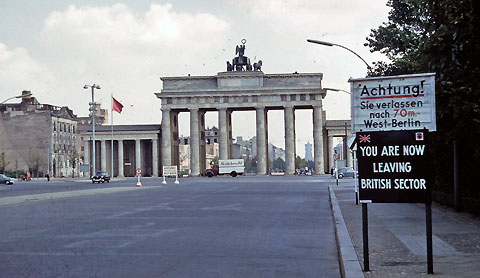![]()
What you must do in this unit
- Read chapters 27 and 28 in the textbook.
- Read my notes for HIS 135 on the Cold War. I also have remarks on Russia and the Cold War and Gorbachev in my HIS 242 course.
- Check out Professor Campbell's video, Was The Cold War B.S.?
- Study the Questions to Consider and the Key Terms for the unit.
What you can do in this unit
- Mike Oliver, former student in HIS 135, has created a good online timeline of the Development of the European Union.
- Check out the excellent timeline of the Berlin Wall (created using Tiki-Toki) by Cameron Peters, former student.
- Korea was one of the most important events of the early Cold War. See the excellent timeline, Significant Events of the Korean War, created by Kelton Adams-Elkins, Alex English, and Christopher Belcher, former students.
- Listen to some further information about this unit as a mp3 file. You can also read the information as a txt file.
Some videos that you can watch for this unit
- Ich bin ein Berliner - John F. Kennedy's visit to Germany in 1963
- See also the videos dealing with Russia and the Cold War in the HIS 242 course.
- For extra credit please suggest to your instructor a relevant video for this unit of the course. Send the title of the video, the URL and a brief explanation of why you find the video interesting and applicable to the material that is being studied in this unit.
Extra Credit Options
- Submit an Extra Credit Special Project paper (point value varies). There are two Cold War museum options available.
- For up to 50 points of extra credit, read Aleksandr Solzhenitsyn, One Day in the Life of Ivan Denisovich, and submit the Solzhenitsyn paper.
- Read George Kennan's "The Sources of Soviet Conduct". In a one-page paper, given the benefit of hindsight, assess the accuracy of Kennan's remarks almost fifty years later for a maximum of 50 points extra credit.
- For up to 25 points of extra credit, watch the movie Dr. Strangelove, or How I Learned to Stop Worrying and Love the Bomb (1964, directed by Stanley Kubrick), released at the very height of the Cold War. In a one-page paper, explain why or why not a similar-type of movie poking fun at the current international situation could be released today.
- For up to 25 points of extra credit, read excerpts of Winston Churchill's Iron Curtain Speech (1946) and then Joseph Stalin's Reply to Churchill (1946) and write a one-page paper comparing the rhetoric on both sides.
- For up to 25 points of extra credit, read the The Tonkin Bay Resolution (1964), and then write a one-page paper, How did the Gulf of Tonkin Incident provide an excuse for United States military involvement in Vietnam?
- For up to 10 points of extra credit, compare and contrast the NATO and Warsaw pact treaties in a short paragraph.
- For up to 10 points of extra credit, read The Helsinki Final Act (1975) and write a short paragraph explaining the purpose of the Accords.
- For up to 10 points of extra credit, read the U.S. and USSR Exchange of Notes on the Berlin Wall (1961) and write a paragraph on the politics involved in the creation of the Berlin Wall.
- For up to 5 points of extra credit, answer the Solzhenitsyn study sheet questions.
- For extra credit, please suggest a relevant website for this unit of the course. Send your instructor the title of the site, the URL and a brief explanation why you find the information interesting and applicable to the material being studied this unit.
Unit Learning Objectives
- Upon successful completion of this unit, you will be able to (1) review the causes and events of the Cold War and (2) assess the worldwide impact of the Cold War.
